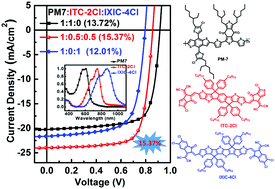A nonfullerene acceptor with a 1000 nm absorption edge enables ternary organic solar cells with improved optical and morphological properties and efficiencies over 15%†
Abstract
Ternary organic solar cells (OSCs) have shown tremendous potential in improving the photovoltaic performance of single-junction OSCs. Here, a series of ternary OSCs are fabricated with PM7:ITC-2Cl as the host system and an ultra-low bandgap acceptor named IXIC-4Cl that has an absorption edge reaching 1000 nm as the third component. The optimal ternary OSC shows a power conversion efficiency (PCE) of 15.37%, which is significantly higher than those of the binary counterparts based on PM7:ITC-2Cl (13.72%) or PM7:IXIC-4Cl (12.01%). The excellent PCE is mainly attributed to the increased short-circuit current (JSC), which mainly arises from the complementary absorption of the third component and thus the overall broadened absorption profile. In addition, the addition of IXIC-4Cl into the PM7:ITC-2Cl binary system suppresses bimolecular recombination, improves charge dissociation and the collection efficiency, balances charge transport and reduces the domain size, which are responsible for the enhanced JSC. Noticeably, the optimized ternary device shows a PCE over 15% with a quite small energy loss, which are the best results for ternary OSCs to date. These results offer more insight into the role of an ultra-low bandgap non-fullerene acceptor as the third component in promoting the device performance of ternary OSCs.



 Please wait while we load your content...
Please wait while we load your content...